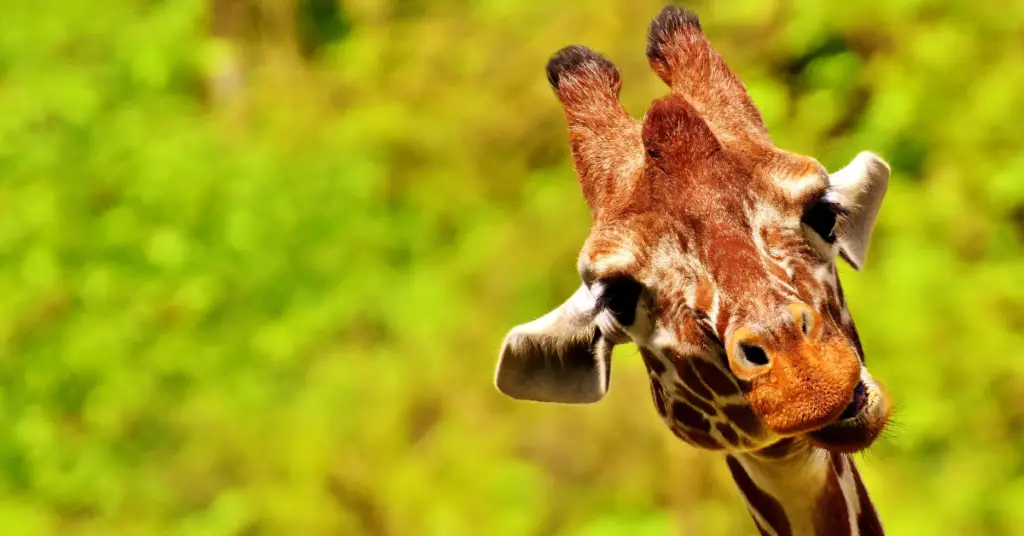The giraffe (scientific name – Giraffa camelopardalis) is an African animal and the largest of all terrestrial animal species. Giraffes live in arid regions ranging from open and wooded forests to semi-desert areas. They live in open grasslands or woodlands but their preference is a habitat rich in thorny acacia trees.
The name giraffe has an Arabic origin, word “zarafah”, which means “one who walks quickly”.
A giraffe’s heart can weigh 10 kg and measure up to 60 cm in length.
The giraffe sleeps 35 hours at short naps of 12 to 15 minutes.
Giraffe’s spot pattern is as unique as human footprints.
During drought, giraffes can cause serious damage to the environment by exploring different types of shrubs and trees. Their overseas geographic range is 10 – 30 million square kilometers over sub-Saharan Africa. Giraffes do not migrate.
Giraffe gestation is around 14 to 15 months, after which a single calf is born. and are approximately 1.8m tall. A few hours after birth, the young are able to run and are fiercely protected by their mother.
Giraffes feed mainly on the leaves, shoots, and seeds of the thorny acacia. Their long, nimble tongue allows them to effectively remove most of the leafy vegetation from a shrub or tree while avoiding sharp thorns.
Giraffes deposit about 70 kg of dung each day.
A giraffe can survive for weeks without drinking water and can tolerate periods of drought due to its ability to extract moisture from plants.
There are sightings of giraffes coming to farms to eat crops, but only if there are no immediate threats to the herd. It is usually considered a minor pest by African farmers. Giraffes avoid people and disturbed areas.
Giraffes are very shy animals that are quite easily disturbed by human activity.
Giraffes are not friendly and can injure or kill you.
At 15 to 20 feet tall, the giraffe is the tallest mammal in the world. Height(average adult)males 5.3 m (17 ft 4 in), females 4.3 m (14 ft 2 in) Weight (average adult) male, 200 kg (2,600 lb) females 830 kg (1,800 lb). Largest male recorded at 6 m (19+ ft); heaviest recorded at 1,900 kg (4,200 lb).
Forelimbs and hindlimbs can deliver a deadly kick.
Speed 50 km/h for longer periods; calves under 3 m tall can be faster than adults.
Tongue measures 50 cm.
Longevity 25 years.
Social behavior varies from solitary (often older males) to large, loose, mixed herds.
Age at sexual maturity –4 years; in estrus 1 day every 2 weeks. The reproductive lifespan is about 15 months (453–464 days).
While a giraffe’s long legs and neck help it lookout for dangerous the African savanna, the giraffe’s height also makes it an easy target for predators.
Giraffe populations have increased from 155,000 in 1985 to 80,000 in 2018 according to the African Wildlife Foundation. Of the nine giraffe subspecies, three subspecies are under 1,000.
As one of the most iconic species in the world, giraffes are at the forefront of ecotourism and conservation, benefiting wildlife in addition to giraffes.
Giraffes live in harmony with other herbivores and play a vital role in the local ecosystem. As plants and fruits pass through their digestive system, they release seeds and allow plants to sprout.
NASA scientists studied the blood vessels in the legs of giraffes to find ideas on how to make spacesuits.
Because giraffes can spot predators such as lions and hyenas from far away, many animals use giraffes as their early warning system. When the giraffes start running away, the other animals run away too.
THREATS
• Habitat loss, civil unrest, illegal poaching and hunting, and climate change collectively contribute to the decline in giraffe populations.
• Climate change and habitat loss have also caused the decline of the acacia tree, the main food source for giraffes.
• United States trophy hunters import at least one giraffe every day.• Giraffe tails and their meat are thought to be a status symbol.

Erzsebet Frey (Eli Frey) is an ecologist and online entrepreneur with a Master of Science in Ecology from the University of Belgrade. Originally from Serbia, she has lived in Sri Lanka since 2017. Eli has worked internationally in countries like Oman, Brazil, Germany, and Sri Lanka. In 2018, she expanded into SEO and blogging, completing courses from UC Davis and Edinburgh. Eli has founded multiple websites focused on biology, ecology, environmental science, sustainable and simple living, and outdoor activities. She enjoys creating nature and simple living videos on YouTube and participates in speleology, diving, and hiking.

